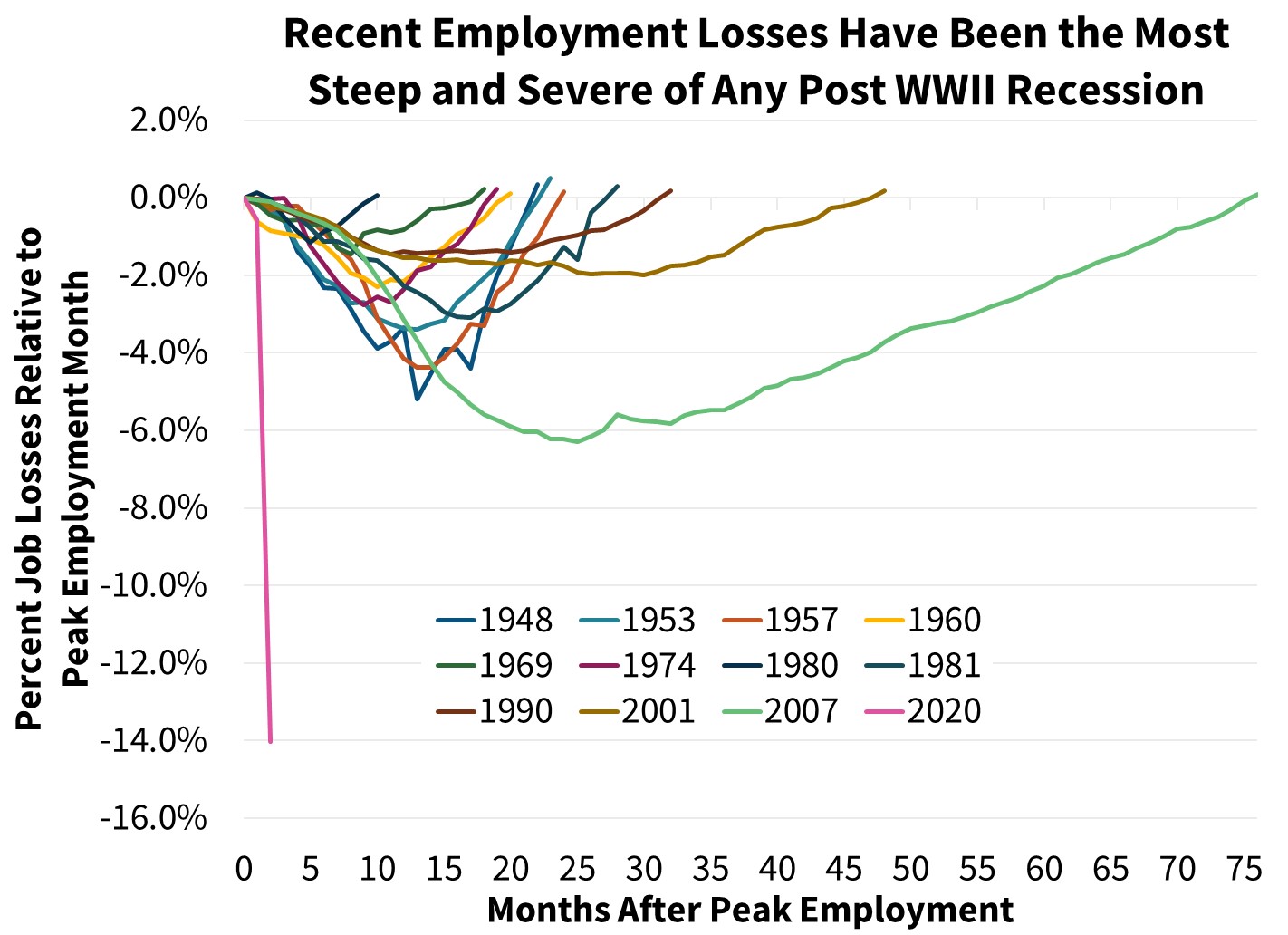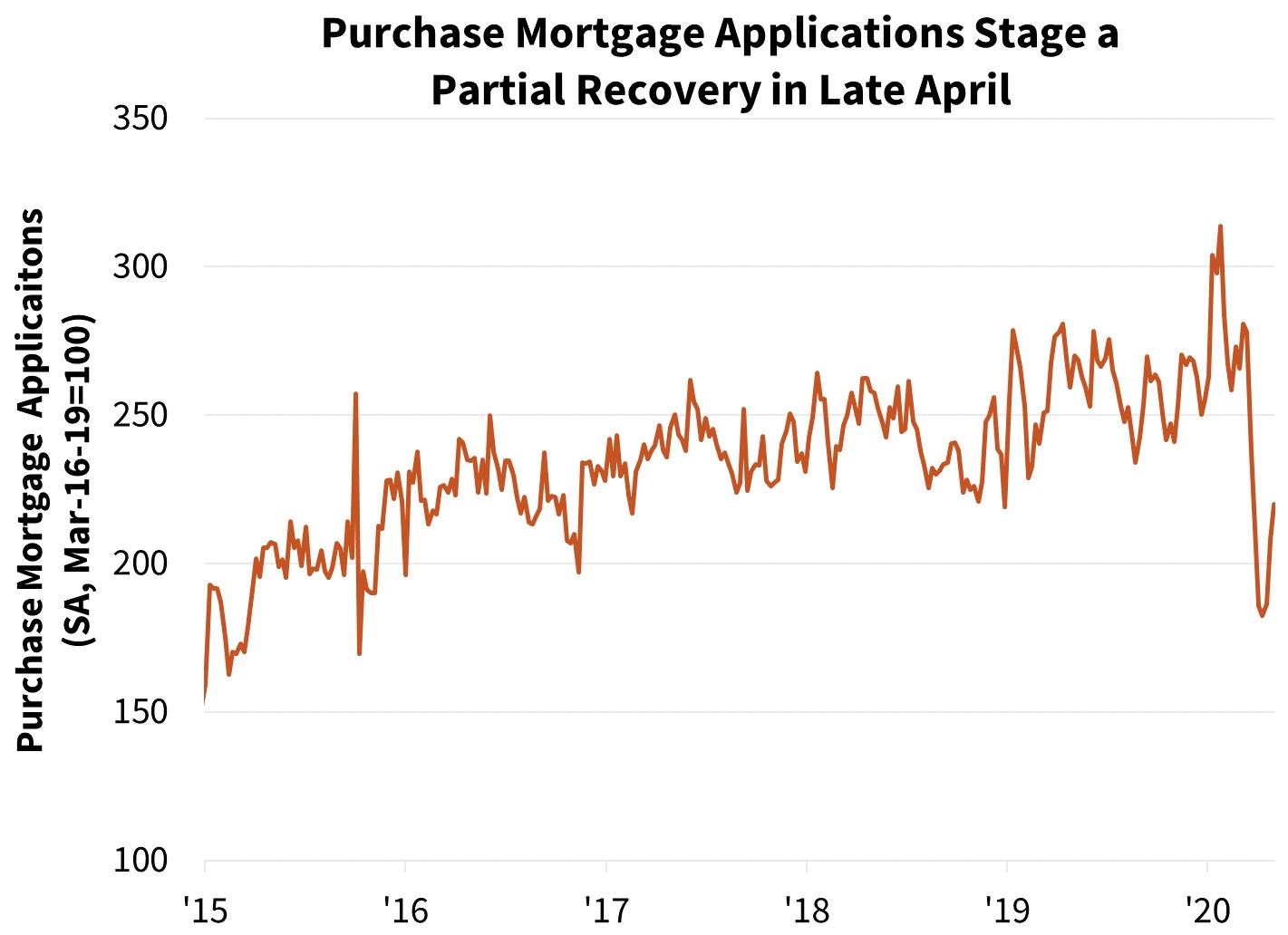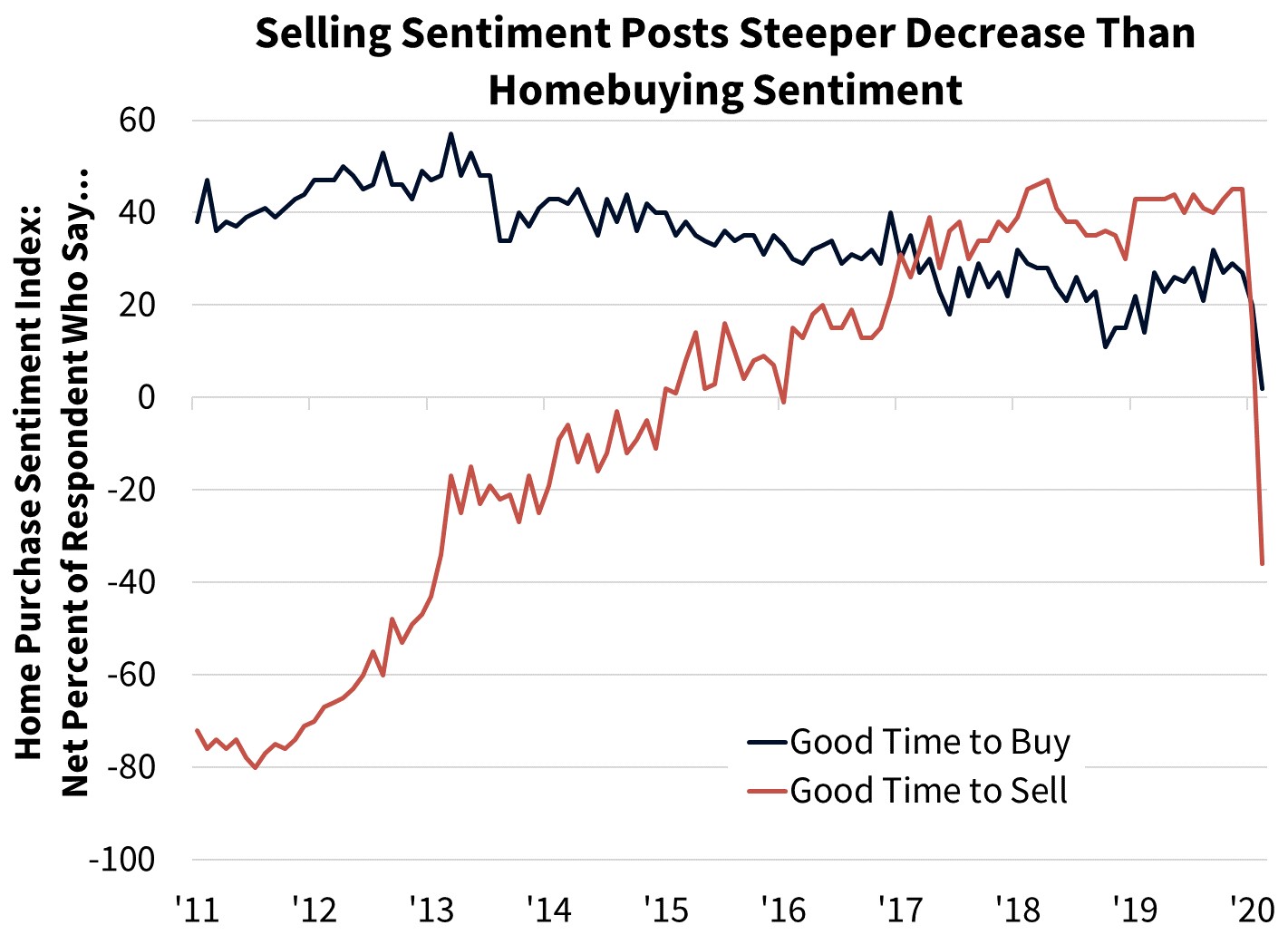Further Growth Contraction Expected Following Q1's Decline
First quarter real gross domestic product (GDP) fell at an annualized rate of 4.8 percent, the first decline in GDP in six years and a larger decrease than the 3.3 percent we previously forecast. The difference was driven primarily by a larger-than-anticipated slowdown in personal consumption expenditures (PCE). Counterintuitively, the difference mostly owed to a sharp decline in healthcare expenditures, which accounted for almost 40 percent of March’s consumer spending decline. Many elective healthcare services were delayed or cancelled in preparation for the response to COVID-19 (coronavirus).

This short-run dynamic is also the primary reason we downgraded our forecast of second quarter GDP, which we now expect to decline over 35 percent on an annualized basis. We forecast a partial recovery in the remaining quarters of 2020, with healthcare consumption providing outsized support. As coronavirus restrictions and social distancing measures are relaxed, we believe that an elevated savings rate, supportive monetary and fiscal policies, and pent-up demand will start to drive the economic recovery. Full-year 2020 GDP is expected to contract 5.3 percent, while 2021 growth is forecast to be 5.2 percent.
Housing was a bright spot in the first quarter, with residential fixed investment posting the largest annualized gain since 2012, but disruptions from the coronavirus are now severely impacting the sector. Listings of single-family for-sale homes fell sharply year over year in April, as potential sellers delayed putting their homes on the market. New construction activity has slowed, and construction employment fell sharply to begin the second quarter. Some high frequency weekly data suggest a recent, modest firming of home purchase activity, but for the second quarter we expect home sales to decline about 31 percent. The low interest rate environment is expected to persist for the remainder of the year, with mortgage rates potentially falling below 3.0 percent by the start of 2021, which, combined with our expectation of a recovery in employment, should support housing activity. Nevertheless, while recovering from its current pace, we still expect home sales in 2020 to be 15 percent below 2019. Given our interest rate forecast and incoming data, we upgraded our refinance originations forecast by $119 billion to $1.5 trillion, levels similar to 2012, when the last refinance boom occurred.
Both Downside and Upside Risks for the Macro Forecast
We do not expect meaningful increases in economic activity to begin on a monthly basis until June, and, even then, how confidently consumers and firms react remains highly uncertain. Record job losses occurred in April, and more are expected in May based on recent unemployment insurance claims filed. Household financial stress as reported in Fannie Mae’s National Housing Survey® and infection avoidance efforts will also likely continue. While some regions have already begun to lift stay-at-home orders, there remains a high level of uncertainty about how people will respond after the economy reopens.
The recent financial disruptions and increased volatility may lead to more cautious consumers, of whom a large percentage may prefer to remain under a self-imposed quarantine, limiting the upside potential for rebounding consumption growth. This, in turn, could increase the magnitude of bankruptcies and permanent firm closings, slowing the speed of recovery in part due to a loss of institutional knowledge and human capital. Another downside risk is the potential for a second, longer lasting or more severe outbreak of the coronavirus later this year than we are currently assuming, possibly leading to renewed social distancing measures. Together, these risks could lead to a lower growth path.
The upside scenario is one in which the rebound from the coronavirus-driven declines in the first half of the year is more pronounced and rapid than we currently anticipate. Under our baseline forecast, GDP would not return to its pre-coronavirus level until late 2022 or early 2023. We assume that moving into the winter there will either be a modest increase in the infection rate or increased level of distancing measures enacted aimed at preventing such an outbreak, dampening consumer behavior in early 2021. However, if consumer and business confidence surges following the reopening of the economy and a combination of increased testing and coronavirus therapies emerges, a dampening of recovery may not occur, and a return to pre-coronavirus levels of GDP could be realized sooner.
Job Losses Will Likely Contribute to Declining Consumer Spending, Including on Healthcare
In April, total nonfarm payroll employment fell by 20.5 million people, or approximately 13.5 percent from the previous month. Prior to this historic drop, the largest percentage decline was 4.8 percent, recorded in September 1945 following World War II demobilization. Last month, the unemployment rate rose 10.3 percentage points to 14.7 percent, the largest ever one-month increase. According to the Bureau of Labor Statistics, unemployment would have been even higher if not for certain likely classification errors regarding temporarily unemployed workers being counted as employed but absent from work. Additionally, the unemployment rate was also offset by a large number of people leaving the labor force. Without these two factors, the unemployment rate easily could have surpassed 20 percent.

Job losses were heavily concentrated in the service-providing sectors, though the goods-producing sector also experienced employment declines. Within the service-providing sector, job losses spanned most of the sub-sectors, but leisure and hospitality were hit the hardest, losing about 8.2 million jobs over March and April. Average hourly earnings growth jumped to nearly 8 percent on an annual basis. However, the jump was due to a composition shift of jobs rather than rising wages. Lower-wage sectors, such as hospitality and food services, have generally been hit hardest by the pandemic, while higher-wage sectors have been comparatively insulated to date, in terms of employment.
The sharp decline in payroll employment supports our expectation of a significant contraction of approximately 40 percent annualized in consumer spending this quarter. Early evidence of this can be seen in the historic drop of light vehicle sales in April, which posted the second straight month of double-digit declines and fell to the lowest level since the series began in 1980. Consumers were already reducing non-essential purchases in March, as seen in the historic decline of outstanding revolving credit (mainly credit card debt) and we expect this to continue in the short run. The flip side to consumers delaying purchases in March was an increase in the personal saving rate, which rose to the highest level since 1981 and should help support a recovery in economic activity later in the year. Higher savings suggest that consumers will have a greater capability to resume purchases and spending as social distancing measures are relaxed.
Declining consumer spending in the second quarter will likely also be driven by the continued low pace of healthcare expenditures, which represents about a fifth of total PCE. In the first quarter, real healthcare expenditures declined 18 percent annualized, subtracting 2.3 percentage points from GDP, and we are expecting an even larger decline in the second quarter. Despite the pandemic, the healthcare sector also experienced unprecedented employment losses in April, with over 1.4 million jobs lost. Uncertainty remains over how much of these expenditures have been deferred versus foregone completely, but we believe relative to consumer spending as a whole, healthcare expenditures will experience a more robust rebound in the second half of the year, helping drive third quarter PCE growth.

Housing Activity Likely to Slow in Q2, But There Are Signs of Life
Housing activity appears to have slowed earlier in the year than we had previously thought. Existing sales fell 8.5 percent over March. Given that sales are recorded at the point of closing, the decline reflected contract signings in February or even January, prior to the March slowdown. It is plausible that some transactions were delayed into April as coronavirus-related distancing measures disrupted the buying process, but many deals may have fallen through at varying stages. More recently, high frequency weekly data, including purchase mortgage applications, sales listings, and our analysis of Google Trends data, suggest that there has been some stabilization of homebuying activity. While we continue to expect a sharp decline in existing home sales over the second quarter, down nearly 30 percent, we revised the sales pace up modestly from last month’s forecast to reflect this recent uptick in data. We expect sales to recover somewhat in the second half of 2020, but for the full year we forecast a decline of approximately 15 percent.

While both supply and demand side factors are contributing to declining sales, we believe supply-side dynamics are more prominent currently, as would-be home sellers decline to list their homes due to infection avoidance concerns or belief that market conditions are unfavorable. According to Corelogic, new listings of single-family homes for sale were down 40 percent from the year prior in April, a decline steeper than our near-term forecast for sales. In April, Fannie Mae’s Home Purchase Sentiment Index® (HPSI) posted a record decline, falling to its lowest level in over eight years. Attitudes about whether it is a good time to sell a home fell sharply relative to a comparably modest decline in buying sentiment. The tightening of housing supply will likely help soften the downward pressure on home prices, even as sales volumes decline. According to Realtor.com, many sellers have been reluctant to cut prices, and have opted to take their homes off the market and wait for social-distancing measures to ease before considering price cuts.

In the long run, we expect the limited supply of homes available, especially in the starter-home segment, to continue to be supportive of home building. However, in the current quarter, new construction is expected to decline sharply. Single-family housing starts fell 17.5 percent in March, to the lowest level in nearly a year, and residential construction employment declined in April. Similarly, new sales fell 15.4 percent in March, the largest monthly decline since July 2013. In April, the National Association of Housing Market Index dropped sharply, posting the largest decline in the survey’s 35-year history. Both the current sentiment and the outlook for the next six months fell to the lowest levels in nearly 8 years, and the Federal Reserve reported tightening of lending standards on construction and development loans. However, as is the case with recent high frequency data, some homebuilders have indicated an uptick in buyer interest in recent weeks. Primarily due to prior data revisions, we revised downward our forecast of new sales and starts for the second quarter. We expect housing construction to contribute to the economic recovery in the second half of 2020, but, for the year, single-family starts and sales are forecast to decline 10.1 percent and 14.6 percent, respectively.
Multifamily construction also fell in March, with starts falling 31.7 percent. Due in part to both the more complicated permitting and financing processes associated with multifamily construction and the different geographic distribution, we expect multifamily starts to decline more sharply in the second quarter relative to single-family construction. We currently forecast multifamily starts to decline 43.5 percent in the second quarter and to be down 10.5 percent for all of 2020.
For more on multifamily market conditions please see the May 2020 Multifamily Market Commentary.
Overall, we expect residential fixed investment in the second quarter to fall over 50 percent on an annualized basis. After troughing in the second quarter, housing activity should see some recovery in the second half of the year, though we do not expect it to return to pre-crisis levels until 2022. A weaker job market and tightening of lending standards for homebuyers and builders relative to those at the start of 2020 will likely continue to be a drag on activity, even when concerns over the coronavirus eventually subside.
Low Mortgage Rates Continue to Support Refinancing, Though Credit Standards Tighten
According to the Federal Reserve, for the three months ending in April, banks reported a net tightening in lending standards for residential mortgage loans. This is only the second quarter in six years in which lending standards have tightened for mortgages. Jumbo loans, in particular, saw significant tightening, whereas government loans were the only category to see a net loosening. Despite the overall tightening in credit standards, banks reported strong demand for mortgage loans.
While housing demand has softened, it continues to be supported by low mortgage rates, which are also fueling continued refinance activity. In April, the average 30-year fixed mortgage rate was 3.31 percent, according to Freddie Mac. With the 10-year Treasury averaging around 0.7 percent in April and our expectation that it will not rise above 1.0 percent in the near future, we believe the currently wide mortgage spreads will narrow as capacity constraints are alleviated, leading mortgage rates to fall further. By the beginning of 2021, we believe mortgage rates could fall below 3.0 percent. On the other hand, heightened uncertainty about job security and disruptions to household wealth may lead potential homebuyers to be more wary of substantial, long-term financial commitments such as mortgages. It is also unclear at this point to what extent the use of forbearance agreements will limit future mortgage demand. According to the Mortgage Bankers Association, 7.9 percent of outstanding mortgages were in forbearance agreements as of the week of May 3, up from 0.3 percent as of the week of March 2. However, the pace of forbearance growth has slowed in recent weeks.
Our forecast for purchase mortgage originations is largely unchanged from last month. We are currently projecting 2020 purchase origination volumes of $1.1 trillion, a decline of 15 percent from 2019, corresponding to the expected decline in home sales and starts. We expect purchase volumes to recover to $1.3 trillion in 2021 as housing activity improves. Meanwhile, we revised upward our refinance originations forecast based on our expectation of a continued low interest rate environment. We are currently projecting 2020 refinance origination volumes to total $1.5 trillion, $119 billion higher than our previous forecast. While refinance applications have fallen of late (down 22 percent in April, according to the Mortgage Bankers Association), they remain at elevated levels; therefore, we expect the pipeline of refinances to continue in the near future. We project refinance originations to decline to $1.2 trillion in 2021, unchanged from last month’s forecast.
Economic & Strategic Research (ESR) Group
May 11, 2020
For a snapshot of macroeconomic and housing data between the monthly forecasts, please read ESR's Economic and Housing Weekly Notes.
Data source for charts: Google Trends, Johns Hopkins CSSE, Mortgage Bankers Association, Bureau of Labor Statistics, Fannie Mae ESR Group.
Opinions, analyses, estimates, forecasts and other views of Fannie Mae's Economic & Strategic Research (ESR) Group included in these materials should not be construed as indicating Fannie Mae's business prospects or expected results, are based on a number of assumptions, and are subject to change without notice. How this information affects Fannie Mae will depend on many factors. Although the ESR group bases its opinions, analyses, estimates, forecasts and other views on information it considers reliable, it does not guarantee that the information provided in these materials is accurate, current or suitable for any particular purpose. Changes in the assumptions or the information underlying these views, including assumptions about the duration and magnitude of shutdowns and social distancing, could produce materially different results. The analyses, opinions, estimates, forecasts and other views published by the ESR group represent the views of that group as of the date indicated and do not necessarily represent the views of Fannie Mae or its management.
ESR Macroeconomic Forecast Team
- Doug Duncan, SVP and Chief Economist
- Eric Brescia, Economist
- Rebecca Meeker, Financial Economist
- Mark Palim, VP and Deputy Chief Economist
- Nick Embrey, Economist
- Richard Goyette, Business Analyst
